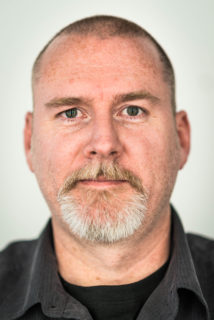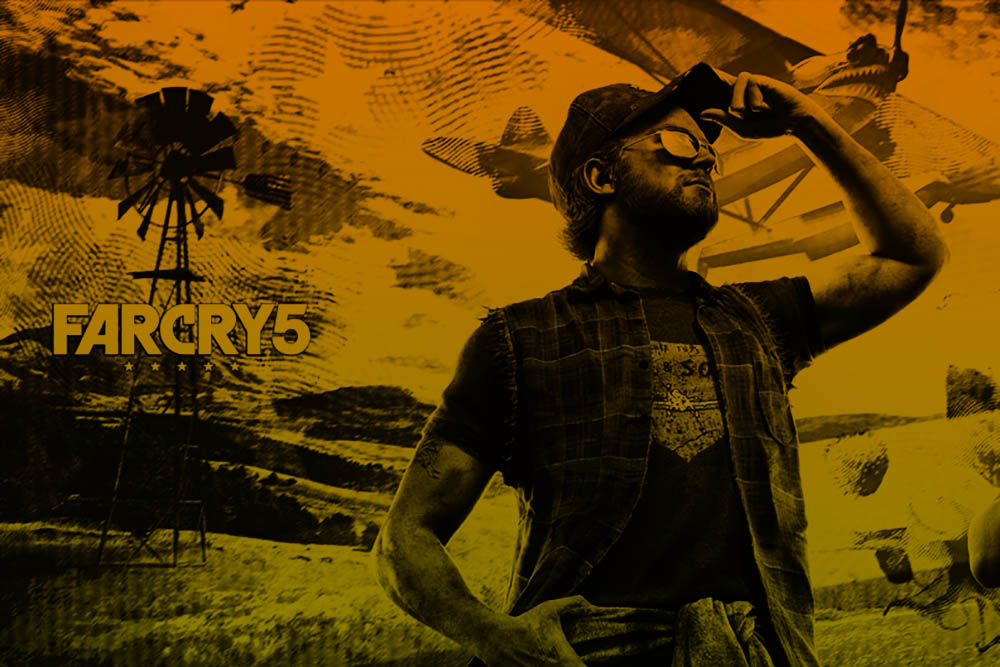The Far Cry series is famous for featuring far-off and exotic locations, where players are challenged to rise up against crazed villains. However, that seemed to take a sharp turn in the opposite direction when Far Cry was announced in May, with a location set in a place called Hope County, Montana.
As Dan Hay, executive producer for the Far Cry brand and creative director for Far Cry 5, explained at his E3 presentation, Hope used to be an idyllic area, but it has been overrun by a fanatical cult and there is no access to emergency services. Therefore, players must find ways to build up a resistance movement to take down the cult. This includes taking computer controlled characters and animals with you on your journey using the newly announced Guns for Hire and Fangs for Hire systems. Although the game got a strong reception at E3, it also received quite a bit of controversy, especially given the current political climate.
Speaking with AListDaily, Hay describes the “anecdote factory,” a world where systems collide with each other, as being at the heart of the Far Cry franchise. Players walk into a world, meet its characters, and deal with them however they choose, often with unexpected results. According to Hay, players essentially craft their own story and the Far Cry experience is about “freedom, opportunity and surprise.”
Hay compared Far Cry 5 to previous games by saying that the development team wanted to give players an open world first-person shooter experience that was both familiar yet uniquely different from previous games such as Far Cry 3, Far Cry 4 and Far Cry Primal. In those games, players followed a somewhat linear path to meet new characters and complete the story.
Why Montana?
Previous Far Cry games took place in fictional far-off locations such as a tropical island in the South Pacific and a fictional country in the Himalayan Mountains, so it came to a shock for many when it was revealed that Far Cry 5 would take place in a fictional county set in the real state of Montana, which is neither far off nor exotic (at least to Americans).

When asked why the game is set in a real-life state, Hay responded by saying that the team had wanted to do a Far Cry set in the United States for a very long time, dating back to around 2012 when Far Cry 3 released. However, no idea seemed to work at the time, so it was shelved until the release of Far Cry 4 in 2014, when the developers were considering locations for the next game. Actually settling on the location is a story in itself.
Hay recounted when he lived in the US for nine years and how he observed a general sense of dissatisfaction and unease that came after the subprime mortgage collapse. It reminded him of the sense of unease he felt as a child during the final years of the Cold War, and how people felt that things could end at any moment and that they had no control over their futures.
“With the subprime mortgage collapse, people felt frustrated that their future wasn’t safe, and the same type of feeling came back from when I was a kid of not having control over my future and someone could just take it away,” said Hay, and that was one of the reasons why the US was now the ideal setting for a new Far Cry game. However, the team wouldn’t have run with the idea if the issue was limited to the United States. Then the surprise of the Brexit vote occurred in 2016, indicating that there was a global sense of discontent and fear.
“The language began to change from the global village to one of ‘us and them,’” said Hay. That feeling was fully realized when Hay was walking through downtown Toronto one day and saw someone wearing a sandwich board with a “The End is Nigh” type message and he thought that the guy was probably right. That was how they came to the idea of having a magnetic leader named Father Joseph, who heads a doomsday cult, as the main antagonist of the game.
In researching locations for where such a character could establish control, the team discovered that Montana was the perfect location. “It became clear that it was the place that people go to when they want to be left alone from the prying eyes of the government or others. Also, Montana has a history of self-reliance, and that was very Far Cry.
Hay made it clear that although it was Montana’s rugged, frontier atmosphere that made it appealing as a setting, this is very much the Far Cry version of the state. “We wanted to give it that sort of Twilight Zone feel, where the picture was slightly off and a bit askew,” he said, describing the fictional area of Hope County.
Nevertheless, the setting sparked controversy among a subset of conservative gamers, which took shape around the Memorial Day holiday when the game debuted its first trailer. Some have called it a “white genocide simulator,” because many of the cult’s followers in the trailer are white. A (likely fake) petition was created on Change.org, demanding that Ubisoft either make changes to the game—such as moving the setting to Canada, making the enemies to Islamic fundamentalists or turning the cult into a group of misguided American patriots—or cancel the game.
Hay responded to the controversy by stating, “We know that there are different views out there, but think about what the film and television industries have explored. Those industries have been around for a lot longer, but I think the games industry has come of age, and now there’s an opportunity for games to explore different aspects of storytelling. That may be controversial for some folks—and we may step on some things that are unique or different—but since games have come of age, that’s ok. We’re just focused on making a great game. The key thing for us is that, at the end of the day, we can’t forget about the fun. We have to make sure that you’re able to explore the anecdote factory and do it in a uniquely American setting.”
Far Cry: The Ultimate Bar Story
With a wide variety of settings and characters, including the Stone Age for Far Cry Primal, we asked Hay what he thought made for a Far Cry game. He described a Far Cry story as a kind of urban legend that stretches the limits of believability. When listening to ideas, Hay imagines himself sitting in a bar as he overhears someone tell a story about being kidnapped in the South Pacific or surviving a violent far off nation in the Himalayas. Even Primal has a tall-tale-like quality to it, as it deals with what it was like to survive 12,000 years ago.
Imagining Far Cry 5 in this way has left a permanent impression on Hay. He said that, “In talking about the game, the bar I imagine has become an actual bar in Montana, which has changed the way I think about the futures of Far Cry.”
It appears as though fans were eager to be told the story as they lined up to play the game at E3.
“We’re really proud with what we did with the E3 announcement, where a lot of people looked at the game and got to play the game and gave us feedback,” said Hay, explaining how public showing set the tone for future promotions as we draw closer to the February 27, 2018 release date. “People were loving it, so I think it’s a matter of building on that. We have to make sure we allow people to play the game at upcoming industry events and that consumers who really want to play it can get their hands on it. We also have to make sure that we aren’t distracted moving forward. Making games is not easy. You want to execute a vision while making sure you don’t get pulled in a million different directions. While we’re getting the game in the hands of consumers, we have to make sure the Guns for Hire, Fangs for Hire and multiplayer systems are great and that the game is generous.
“E3 can be a good barometer for how you’re doing, testing things, and getting an idea of where you’re going. We feel really good about the response and we know that people are hungry to more about the game and we want to bring it to them.”

